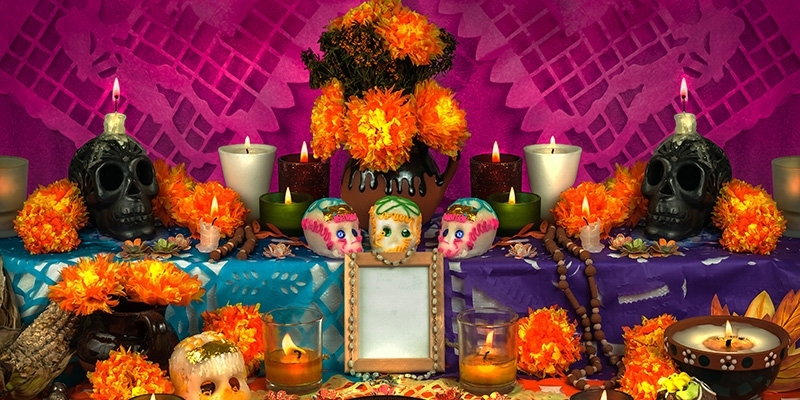
November 2, 2019 - By Ricardo A. Vela - Many of us in the US have seen or heard something about the Mexican celebration El Dia de Los Muertos (Day of the Dead), whether it's a reference in a horror movie or a community fair where children get their faces painted as colorful skulls. For many, that is the extent of their knowledge of this millenary, radiant and vibrant Mexican celebration.
The Day of the Dead is more than a colorful skull painted on someone's face or a skull made of sugar, and it isn't a tradition that includes scaring someone like Halloween - it is not scary at all. This tradition is about celebrating life and renewing love.
The Day of the Dead is an ancient Aztec holiday celebrated throughout Mexico and nowadays by people elsewhere in the world. Mexican culture views death as a natural part of the human cycle, so the day is not a day of sadness, but rather a day of celebration where loved ones return for that day and celebrate with the living. The Day of the Dead festivity is embraced by Mexicans and other ethnic groups living in the United States because it is rooted in love and life.
Today we often find altars for Day of the Dead in schools and community centers. These altars showcase Mexican marigolds (Tagetes erecta), bright and colorful sugar skulls, and elegant Catrinas next to pan de muerto (Mexican bread for the dead)—all of them entwined with photographs and personal items honoring the lives of those who have passed away.
Each element has a unique symbolism in the elaborate altar. The petals of the marigold, known by the ancient Mexicans as “Cempasuchitl,” or the flower of the 20 petals, were believed to guide the dead to heaven. The skulls and the bread are a fusion of Christianity and the original ancient celebration.
Mainstream America appears to be glimpsing the Day of the Dead festivity more clearly each year, and its fascination with it grows. Prestigious museums, like the Smithsonian and the Peabody museums, as well as the Palm Springs Museum of Art, among others, dedicate important space to this celebration.
For Claudia Diaz, a 4-H UC ANR Youth Development advisor for Riverside and San Bernardino Counties, Day of the Dead brings memories of her time in Mexico City with her family. “My family and I traditionally got together in the evening, ate Day of the Dead bread with chocolate and talked about the people we love who are no longer with us,” Diaz remembers.
For Cynthia Orozco, UC ANR Nutritional educator in Los Angeles County, Day of the Dead has a very personal and intimate meaning. “For me, Día de Los Muertos is a festive day; I am going to celebrate my son that passed away. I remember a lot of the beautiful moments that my boy left me,” Orozco said.
Since both Orozco and Diaz work in counties with a high population of Mexican immigrants, they include this celebration into their curricula as part of UC Agriculture and Natural Resources' mission to impact the daily lives of Californians.
“As a 4-H youth development advisor, I am fortunate to bring the tradition back to the kids that have Hispanic heritage,” Diaz says. “In the summer, we make a program where we talk about the Day of the Dead, kids learn how to do altars, and they learn how to do special poems that we call Calaveras.”
While Orozco includes the Day of the Dead meals in her Eating Healthy classes, she also teaches adults and kids how the traditional foods of this and other Mexican celebrations can be made healthier.
The fascination with Day of the Dead is not exclusive to those who work in urban areas. For instance, after a trip to Oaxaca to experience Day of the Dead firsthand, Penny Pawl, UC Master Gardener of Napa County, was taken by the festivities. She even wrote about how to grow Mexican marigold and all its varieties and medicinal properties in the Napa Master Gardener Column.
Day of the Dead is one of the many ways modern Mexicans show their pragmatic way to revere death by celebrating life.
Source: UC ANR









